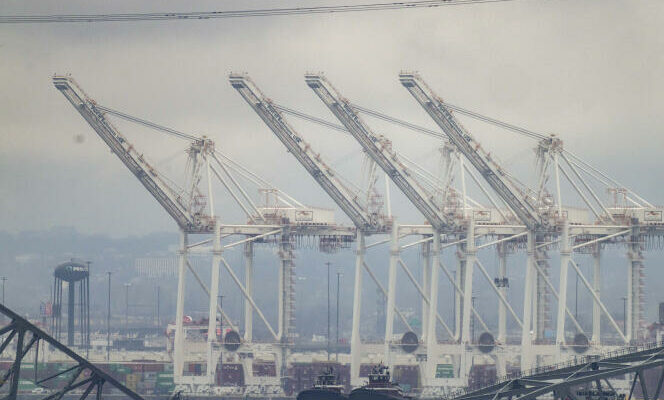It was August 2023. The Port of Baltimore (Maryland) was delighted to receive theEvergreen Ever Maxa 165,000-ton cargo ship capable of carrying more than 15,400 containers. “Why are these huge [navires] want to stop at the Port of Baltimore? It’s no secretgreeted the state transport secretary, Paul Wiedefeld. [Les compagnies maritimes] know that the port is valuable infrastructure and a formidable partner for efficiently moving goods across the state and throughout the region”. And to rejoice at the fifteen meter deep channel and the gigantic cranes capable of unloading such cargo.
Six months later, another cargo ship, with a capacity of only 10,000 containers but almost as monstrous, the Dalí, created the disaster, hitting a pile of the Francis-Scott-Key bridge crossing the bay, which collapsed on Tuesday March 26 around 1:30 a.m. Baltimore and the United States are now wondering what was still a reason for satisfaction in the summer of 2023.
First, there is the question of the size of the ships which has continued to increase over the years, especially since the size of the Panama Canal was widened in 2016. Baltimore was equipped to receive these sea giants. Was this ultimately a good thing? Then comes the subject of the strength of the bridge. This was built in 1977 and was not specially designed to withstand this type of accident, while the channel did not have any protection. With a main span of 400 meters, it was the second longest continuous truss bridge in the United States.
The accident, which left six people missing, now presumed dead, revives an old debate on the obsolescence of American infrastructure, in particular that of bridges, even if it is difficult to see how any steel structure could have withstood such a impact. According to a 2021 report from the American Society of Civil Engineers, 42% of the 617,000 American bridges are at least 50 years old and 7.5% of them are considered structurally deficient, while 178 million vehicles have them. cross every day. However, the last fatal disaster recorded by the press dates back to 2007 when a bridge over the Mississippi in Minneapolis (Minnesota) collapsed, killing thirteen people. The case is therefore exceptional
The work will last months, even semesters. “The federal government will pay the entire cost of rebuilding this bridge, and I hope Congress will support my efforts,” promised President Joe Biden, in the middle of the electoral campaign, adding that “Vessel traffic in the Port of Baltimore has been suspended until further notice. And we’ll have to clear this channel before it can resume.”.
You have 61.29% of this article left to read. The rest is reserved for subscribers.
